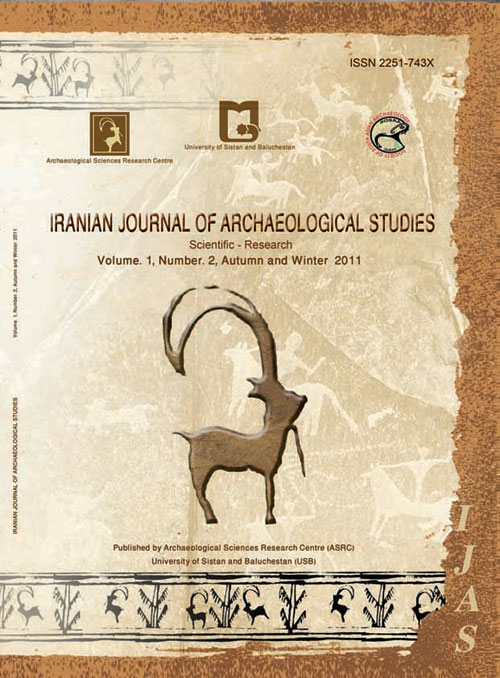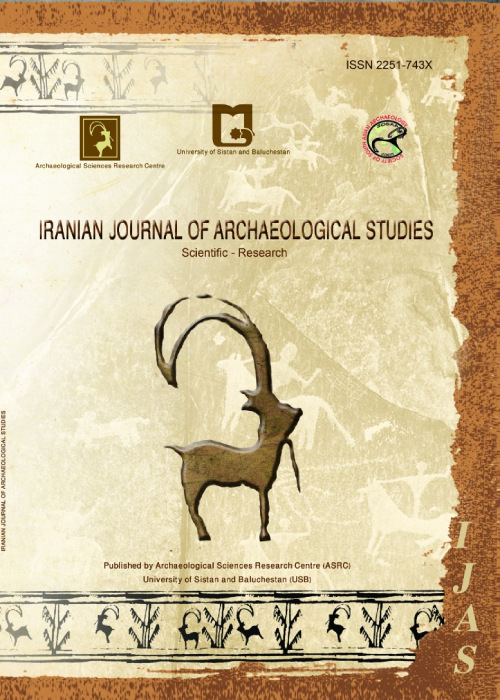فهرست مطالب

Iranian Journal of Archaeological Studies
Volume:7 Issue: 1, Winter and Spring 2017
- تاریخ انتشار: 1395/11/13
- تعداد عناوین: 6
-
-
Pages 1-15
Metalworking, due to its special technical and production-related characteristics, played a very important role in ancient societies and the study of the archaeological evidence related to it is fundamental to understand ancient socio-economic complexities. Mining, smelting, annealing, casting, production of ingot, as well as alloying, are some of the stages in the metalworking process. The present study analyzes the background of the specialized metal production on the Iranian Plateau and the related demand for raw materials or metal products. The central, eastern, and south-eastern areas of Iran are here considered as the most important regions in the formation and expansion of the metallurgy in south-western Asia. In addition, the production and distribution of metal at the regional and trans-regional level was one of the most important factors in the formation and expansion of complex societies, and fostered the political economy and the emergence of agency institutions and sovereignty in these regions of Iran. Copper ingot was one of the commodities traded in the 4th millennium BCE and later. There are two other important points in the field of archaeometallurgy of Iran. Firstly, the specialized metal production process allowed just men to assign strict mining and smelting operations. Secondly, the rulers by means of the strategic activity of metallurgy provided the basis for the continuation of the social and economic benefits acquired by them and the sustainability of the state of society.
Keywords: Archaeometallurgy, 4th Millennium BCE, Iranian Plateau, Socio-economic complexities, Specialized Production of Metal -
Pages 17-27
"Context" has been a major focus of archaeological theoretical studies since the early days of processualism or “New Archaeology”. In both processual and post-processual archaeology, context is more than just a space in which material data can be identified. Instead, it is a set of spatial, chronological, and socio-cultural terms set by the archaeologist through which (and through whom) material culture obtains meaning and function.
In theoretical treatises, context has been divided into two types: dynamic or static. According to an ethno-archaeological research in Bam disaster context (SE Iran) and a pilot area in Pakistani Jamu and Kashmir, a new kind of context is introduced in this article which can be located in the spectrum between dynamic and static. It can be hypothesized that this new kind of context (Disaster context) is not particular and can be observed in sites which have passed the process of becoming an ancient site.Keywords: Dynamic Context, Static Context, Disaster Context, Bam, Kashmir -
Pages 29-44
Tepe Yalfan is one of the Iron Age III sites at the southeast of Hamedan, at the junction of the Simin and Yalfan rivers. This site was excavated in 2006 and 2007, in the frame of the activities related to the construction of Ekbatan Dam, and revealed remains of a mud-brick wall. Potsherd recovered from the excavation indicate an Iron Age III chronology for the site. Comprehensive studies on Iron Age III pottery have rarely been conducted; therefore, the present paper attempts to study classification, typology and chronology of the regional pottery to understand part of the pottery production during the Iron Age III. Typological studies of the pottery from Tepe Yalfan led to a classification into three types: buff, gray and cooking wares. These ceramics were compared to the ones from sites of the Iron Age III, including Nush-i Jan, Godin II, Baba JanII, Sialk VI, the cemetery B at Sialk, and Ozbaki IV. Based on comparative studies, one could date Yalfan to circa 800-600 BCE.
Keywords: Iron Age III, Median period, Tepe Yalfan, Median pottery -
Pages 45-65
Dasht-e Lut (Lut Desert) is archaeologically well-known in Near East thanks to the presence, on its western edge, of the Bronze Age urban centre of Shahdad. In 2012, the author launched a three-season field project in the area of Shahdad, with an agenda articulated around three main research points: an extensive archaeological survey along the western edge of the Lut Desert, the stratigraphic excavations of two multi-period prehistoric sites and, lastly, a systematic surface survey and excavations aimed at delimitating the urban centre of Shahdad. This paper presents the results of the second season of this recent project. Recent excavations at Tepe Dehno and Tepe East Dehno in Shahdad plain have revealed levels dating back to a period from the early 5th to the early 3rd millennium BCE based on C14 absolute dates. A total of 10 charcoal samples from the mentioned excavated sites were analysed using Accelerator Mass Spectrometer (AMS) method. Radiocarbon determinations obtained from the two aforementioned sites have questioned the prehistoric chronology of south-eastern Iran
Keywords: south-eastern Iran, Shahdad, Excavations, Absolute Chronology -
Pages 67-83
Pottery art in Iran reached its apex during the Seljuk and Kharazmshahi eras. In these two periods, artists produced high-quality wares,with Minai decorations which were considered as masterpieces of Islamic art from an aesthetical point of view. These wares were decorated with motifs existing in manuscripts illustrated by artists from Baghdad and Seljuk miniature painting schools portraying epic stories in the Shahnameh or love stories in Nezami’s Khamse. Although very noticeable, influences on Minai wares from miniature works of Baghdad and Seljuk schools have received little attention by researchers. This led researchers to investigate the similarities of motifs remained from Baghdad and Seljuk schools in works such as Varagha and Golshah, Kalileh-and-Dimna and Hariri Maghamat to recognise their influences on the motifs of Mina wares. The main purpose of this paper is to study and explore the impact of Baghdad and Seljuk miniature painting schools on Minai wares and evaluate their respective influences on Minai wares. The methodological approach applied in this study includes historical-comparative analysis as well as researches in libraries and museums resources. Illustrated manuscripts belonging to Baghdad and Seljuk schools were identified, their similarities and differences were singled out and finally their influences on Minai wares were evaluated.
Keywords: influence, miniature, Baghdad school, Seljuk school, Minai wares -
Pages 85-106
The ancient site of Toll-e Gap Kenareh is located 5 Km south-west of Persepolis and approximately 3 Km north-east of the city of Marvdasht, in the Kur River Basin. The first season of excavations at Toll-e Gap was carried out between September and October 2012, with the aim to identify the stratified cultural sequence of the site and to obtain relative and absolute dating for the 3rd millennium BCE in Fars. Two trenches (A and B) were excavated during this season of excavations on the eastern and western sides of the site, reaching the virgin soil at a depth of 5.3 m. On the basis of the recovered potsherds and by virtue of their comparison with other sites in the Kur River Basin, it can be inferred that the chronological sequence found in Toll-e Gap Kenareh displays early Islamic, Sasanian, early Kaftari, transitional Banesh / Kaftari and Banesh (early, middle, and late?) periods. Therefore, Toll-e Gap Kenareh opens new horizons in the archaeology of Fars during the 3rd millennium BCE, above all as far as the transition between the well-known Banesh and Kaftari periods is concerned.
Keywords: Fars, Marvdasht plain, 3rd millennium BCE, Banesh period, Kaftari period, Sasanian period, early Islamic period


